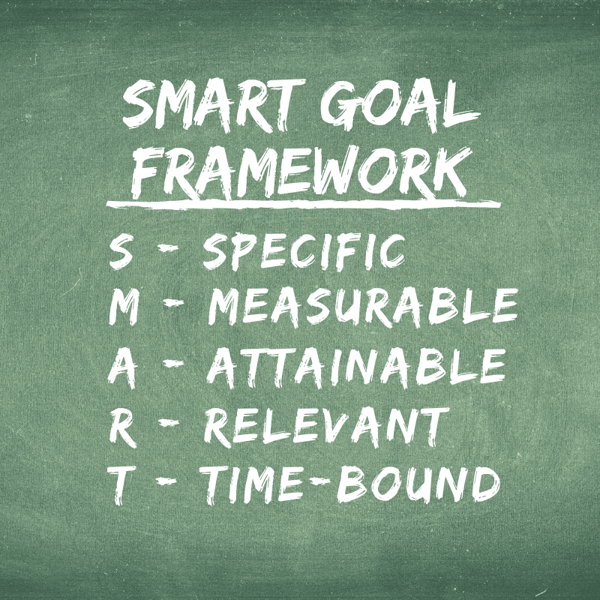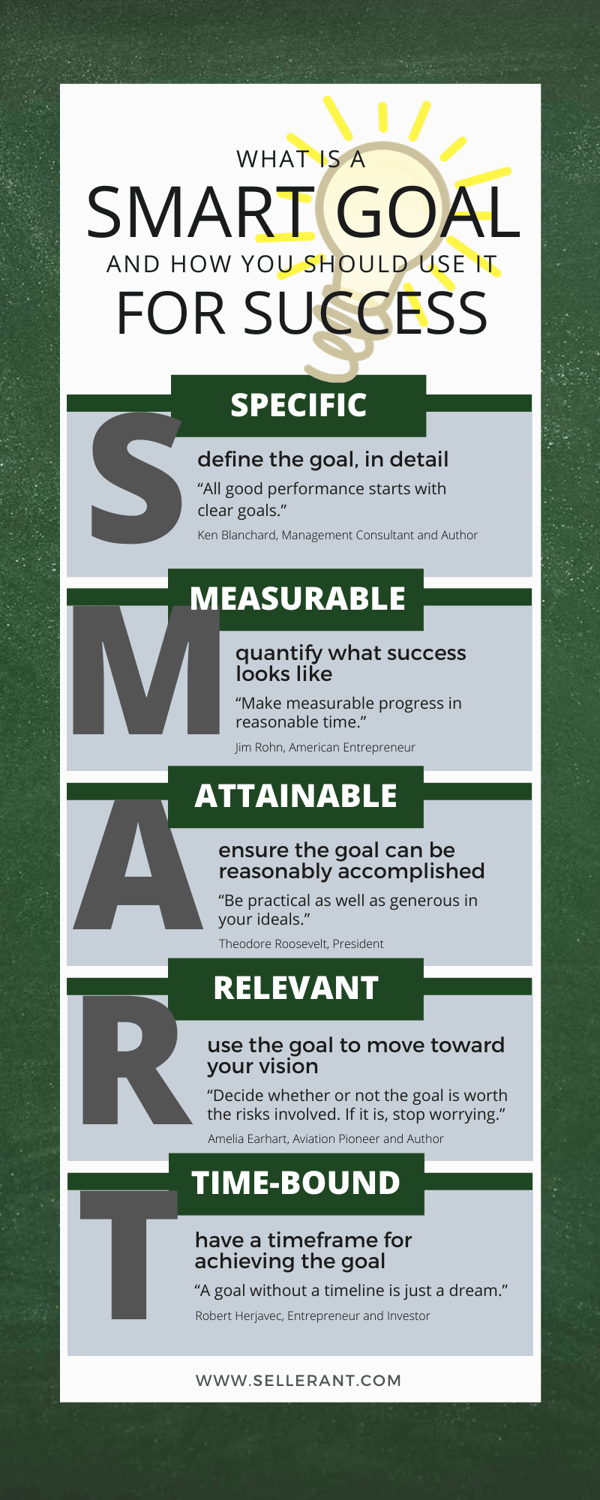SMART Goals are imperative for your growing business or startup.
Success doesn’t just happen. Good leaders understand that leading a business with intentionality requires having goals and a plan for achieving those goals. Using SMART Goals and creating a SMART Goal Framework can help your business grow and scale. As business leadership guru Brian Tracy says, “Goals are the fuel in the furnace of achievement.” Well-defined goals provide clarity, direction, and motivation to drive your business, your teams, and your people.

What are SMART Goals?
The SMART Goal framework is an effective structure for goal setting that provides a systematic process to develop goals that are specific to produce desired outcomes while providing feedback about performance and progress.
Created and published in a 1981 issue of Management Review by George T. Doran, the SMART acronym is sometimes parsed with slightly different words, but always with the same intention. The letters for the easy-to-remember SMART Goal framework are applied to ensure that goals are specific, measurable, attainable, relevant, and time-bound.
Here is the SMART Goal Process:
- Specific: Is the goal well defined and unique enough to provide a distinct description?
“All good performance starts with clear goals.”- Ken Blanchard, Management Consultant and Author
- Measurable: Can you determine quantitative progress toward achieving the goal?
“Make measurable progress in a reasonable time.”- Jim Rohn, American Entrepreneur
- Attainable: Is the goal something that can realistically be accomplished?
“Be practical as well as generous in your ideals. Keep your eyes on the stars, but remember to keep your feet on the ground.”- Theodore Roosevelt, President
- Relevant: Will accomplishing this goal get your business closer to your vision?
“Decide whether or not the goal is worth the risks involved. If it is, stop worrying.”- Amelia Earhart, Aviation Pioneer and Author
- Time-bound: Is there a specific end date for reaching the goal, to create urgency and determine success?
“A goal without a timeline is just a dream.”- Robert Herjavec, Entrepreneur and Investor
Using this framework to plan your business growth combines both the qualitative value that clearly states the desired outcome, with the quantitative measurement that provides definitive progress toward achieving the goal. Whether the goal is a 12-month run rate increase of $2 million or adding and sustaining 50 new customers in the next six months, everyone involved in the execution of achieving those goals can understand what success looks like and how they are progressing toward success. As long as the goal is attainable and relevant, team members can work together as motivated and invested participants in accomplishing the goal.
How Much Detail is Needed To Develop a SMART Goal Plan?
When developing a SMART goal, more detail is usually better than not enough detail. It is easy to understand why a goal of “growing top-line revenue by 25 percent, year over year” is important to the success of a company; however, the goal becomes more valuable when it is more specific. A better goal may look like, “Grow top-line revenue by 25 percent, year over year, by improving the quality and quantity of new leads into the sales pipeline, and grow the value of existing customers.” With this example, the goal is clearly 25 percent Y-o-Y growth, and the strategies will focus on generating new business through improved lead generation and marketing, as well as retaining and upselling existing customers. A well-crafted SMART goal makes an obvious connection to the strategic execution plan for achieving that goal.
Organizational goals that have no clear connection to overall success do more harm than good. Lofty goals like “be the world’s leading…” are simply unrealistic for all but two or three global companies in any given industry. Pursuing a nebulous goal distracts and interferes with everyday performance and employee morale. Tasking a team to meet sales or customer satisfaction improvement goals that far outstrip their capabilities or a realistic level of improvement all but guarantees dissatisfaction and a lack of investment from the people being asked to work toward the goal. This plan ensures that you are able to engage, direct, and motivate team members in both daily activities and longer-term contributions toward a recognizable and achievable success.
SMART Goals Lead To Better Decision Making
Every growing company can benefit from making better business decisions that are aligned with its goals. SMART goals, by definition, provide specific and measurable guidelines that lead to better, informed decision-making. For example, the decision to invest limited time, money, and resources into involvement at an industry trade show should be predicated on alignment with activities that deliver outcomes toward strategies that accomplish a goal, rather than the all-too-often justification of, “but our competitors will be there.” Bootstrapped startups and mature companies alike need to use every tool they can for better decision-making, and this includes building a business case for investment in activities that align with their goals.
Here are some examples of questions to ask while planning your SMART goals
-
How much is the increased visibility from the industry event worth? (Relevant)
-
What level of new business can we expect to gain from being there? (Measurable)
-
Can we use this event to help us become a recognized thought leader? (Attainable)
Asking these types of questions will lead to better information and alignment for moving toward an existing goal, and may create a new, more targeted goal for outcomes from the activity. In the example, setting a goal of gaining 10 new customers from participation in the trade show helps everyone understand why they are going and what they need to do while they are there. A plan may include speaking on a panel, hosting two after-hours events and conducting at least 50 on-site meetings with prospects that stop by a trade show floor booth. An action plan is developed to align activities with the goal for the trade show, which is aligned with a bigger goal for the company’s strategic plan. This level of detail and consideration provides far better information to make the business case decision to participate.
Use SMART Goals For Resource Evaluation
The best goals will present a challenge to an organization, requiring people, processes and tools to perform at their best in order to succeed. The goals you create should not be overly difficult, but should stretch and grow your team's skills and capabilities. This will help highlight outdated or ineffective processes and tools so they may be optimized for better productivity. Shining a light on resources and performance will help leaders uncover opportunities for improvement, investment, and reward.
This process is an effective part of evaluating the current resources available and determining opportunities for improvement. Here are some ideas for questions to ask yourself during your goal-planning process:
-
Does our business have the right people in the right roles, with the right training doing the right things?
-
Does our business have waste, overlap, or inefficiency?
-
Does our business need any additional resources to grow and scale?
The value of analyzing the successes and failures of ambitious goals can include identifying opportunities for resource optimization as well as strengths and weaknesses in systems and processes, uncovering the need for business transformation, better training, or gaps in leadership. Well-developed plans can serve as a blueprint and benchmark for effective performance standards to get the best from people, processes, and tools.
Remove Ambiguity With Performance Reviews
Individual performance reviews are a necessary (and sometimes even frustrating) leadership challenge. This is, in large part, due to a lack of clear expectations of job performance, a lack of quantitative success metrics, and a lack of alignment between individual performance and team or company goals. Using this framework at each level of your organization, from company goals to department goals to team goals to individual goals, provides clarity, direction, and motivation for employees to succeed.
SMART goals enable leaders to align team member activities with big-picture company goals
-
Individual progress can be measured toward higher-level goals with a monthly, weekly, or even daily cadence.
-
Teams can work together with clear and realistic expectations and the ability to adjust in real time for better performance, engagement, and satisfaction.
-
Individuals and their leaders have a clear understanding and alignment for monitoring and measuring performance.
This framework provides a level of transparency that should make performance reviews more of a conversation about confirmation and support than a cause for stress and uncertainty. Individual goals that are aligned with company goals make it easier to reward individual contributions based on company success.
Famed cosmetics entrepreneur Mary Kay Ash talked about the importance of setting goals by saying, “We must have a theme, a goal, a purpose in our lives. If you don't know where you're aiming, you don't have a goal.”
Set SMART Goals that Drive Growth:

